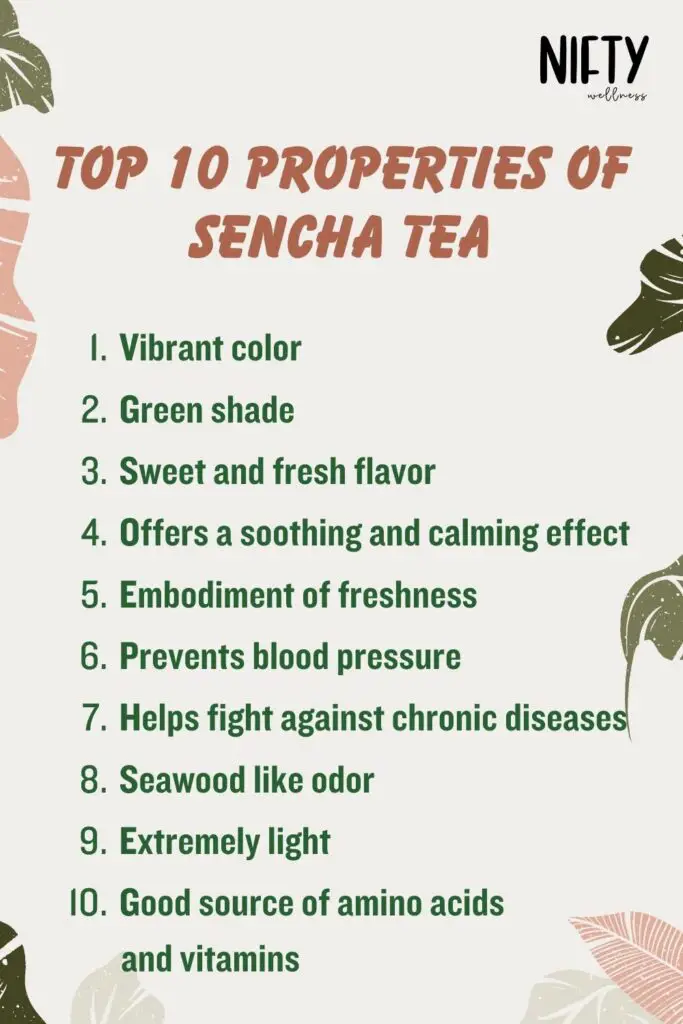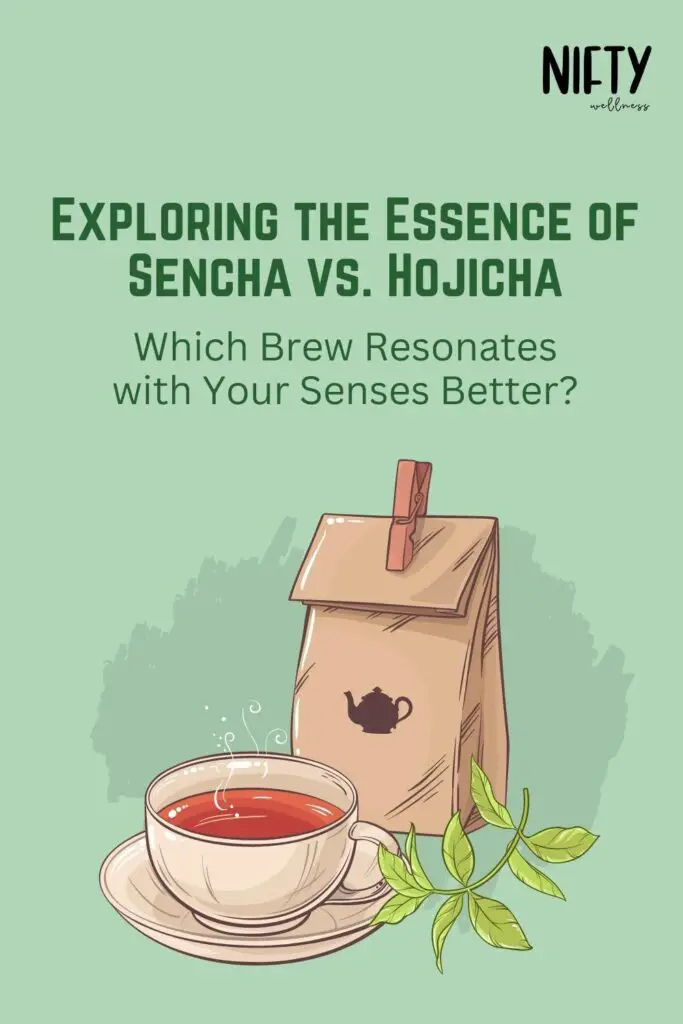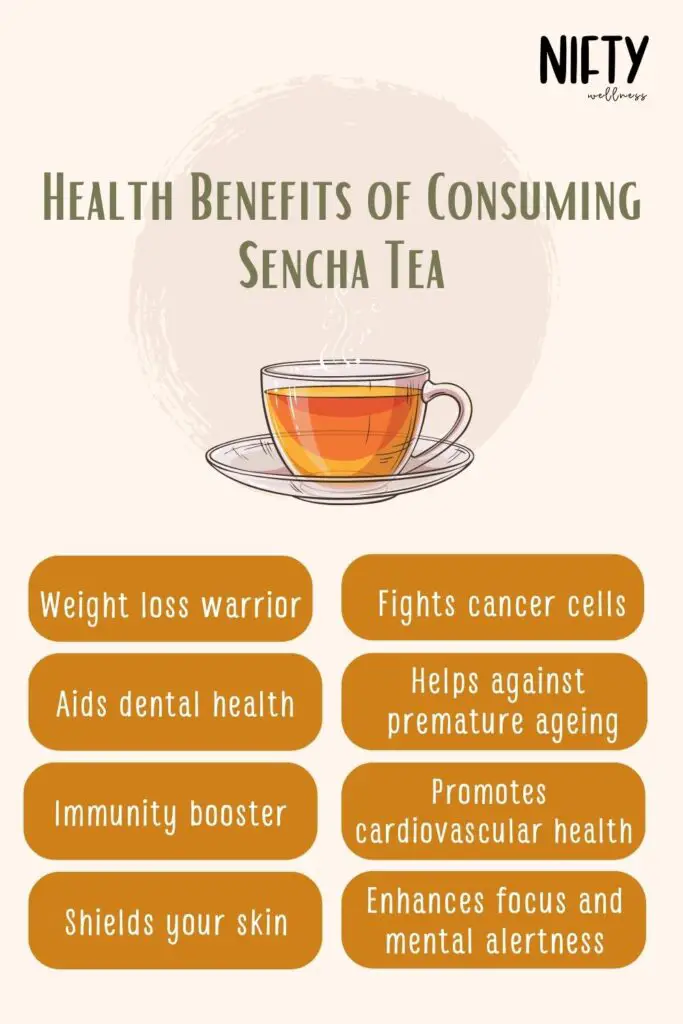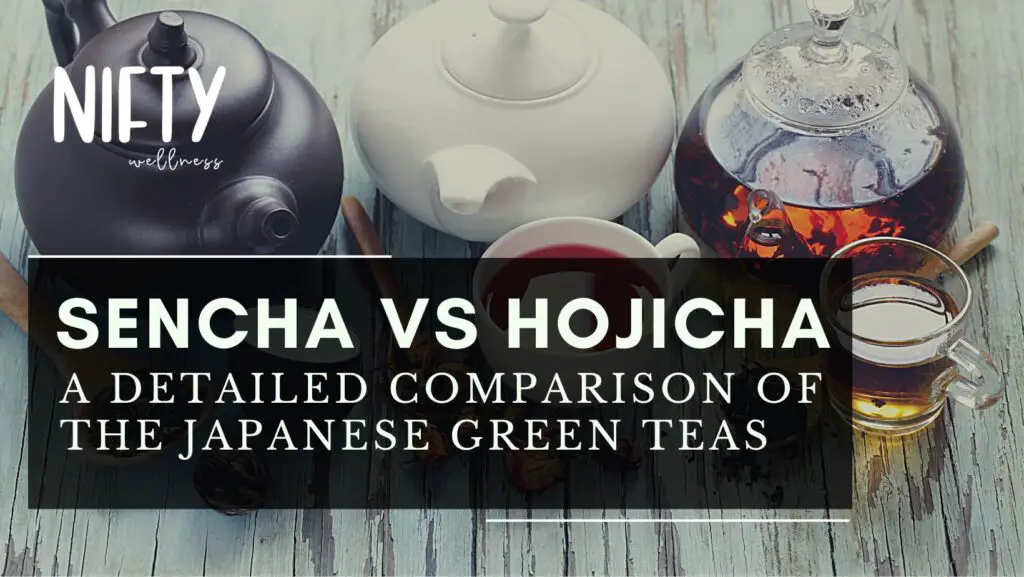In the realm of health and wellness, Japanese green teas have gained immense popularity. With their unique flavors, impressive health benefits, and widespread acclaim, they have become a favorite choice. Among the various Japanese green teas, Sencha and Hojicha stand out as particularly popular varieties.
These two teas, Sencha and Hojicha, have captured the hearts (and taste buds) of tea enthusiasts worldwide. Let’s dive into a detailed comparison of Sencha vs Hojicha, unraveling their unique characteristics. By exploring why these green teas have become an integral part of the daily routine for many health-conscious individuals across the globe, we can truly appreciate their significance.
Understanding Sencha

Definition and Characteristics of Sencha
Sencha, originating from Japan, is a type of green tea known for its exquisite flavor profile. It’s characterized by the unique production process where freshly harvested tea leaves are immediately steamed to halt oxidation, preserving their vibrant green color and fresh aroma. This process gives Sencha its signature grassy notes and prevents the conversion of polyphenols into Theaflavins, which are more commonly found in black teas.
The Primary Attributes and Flavor Profile
The flavor profile and attributes of Sencha are largely determined by the level of steaming it undergoes: asamushi (light), chumushi (medium), or fukamushi (deep). This steaming process locks in the ‘grassy’ or ‘steamed vegetable’ flavors, which come from the high polyphenol content in the leaves.
On the lighter side of Sencha, you’ll find delightful notes of fresh grass and delicate white florals. As the Sencha becomes richer, it transforms into a flavor profile reminiscent of Gyokuro, with hints of dried nori, succulent razor clams, and the earthy embrace of forest moss.
The resulting tea is not as tightly rolled as gyokuro but is more so compared to teas like Tamaryokucha, allowing it to retain its sea-fresh aroma.
Caffeine Content of Sencha
Sencha is known to have a relatively higher caffeine content, making it an ideal morning tea. However, it’s worth noting that the actual caffeine content can vary, depending largely on the shading process and the cultivar from which it originates.
Sencha’s Caffeine Levels
Despite the higher caffeine content, drinking Sencha doesn’t result in extreme jitteriness common with other high-caffeine beverages. A cup of Sencha contains roughly the same amount of caffeine as a quarter cup of coffee. Shaded Senchas tend to have higher caffeine levels, while unshaded Senchas have lower amounts.
Benefits of Moderate Caffeine Consumption
Moderate consumption of caffeine, especially from natural sources like Sencha, has several proven health benefits. These include improved cognitive performance, increased alertness, elevated mood, and even potential protection against certain neurodegenerative diseases. Regular, moderate consumption of Sencha could, therefore, contribute positively to your health and wellness routine.
What is Hojicha?
Understanding Hojicha: Definition and Characteristics
Hojicha, a distinctive variety of Japanese green tea, differentiates itself from other teas through its unique production process. Contrary to the traditional method where leaves are steamed, Hojicha leaves undergo a roasting process. The leaves used are usually older and coarser, which are transformed into a brown hue due to the high-heat roasting. This process imparts a divergence of flavor and a significant reduction of grassy notes in the final product.
The Roasted Flavor and Unique Aroma of Hojicha
Hojicha’s defining characteristic is its roasted flavor profile. The high-heat roasting process eliminates the grassy notes that are typically associated with green tea, replacing them with a unique spectrum of flavors. Lightly roasted Hojicha may express notes of fresh green olives, while a more heavily roasted variant will deliver flavors reminiscent of smoke and roasted rice. The culmination of these notes gives Hojicha its unique, complex, and comforting taste.
The Caffeine Content in Hojicha
Examining the Hojicha Caffeine Content
Just like other varieties of tea, Hojicha does contain caffeine. However, the caffeine content in Hojicha is significantly less when compared to other green teas. This is due to the fact that Hojicha is made from the older leaves of the tea plant, which naturally contain less caffeine. Moreover, the roasting process of Hojicha contributes to the reduction of caffeine content, making it a suitable choice for those looking to minimize caffeine intake.
Comparing Hojicha’s caffeine levels to other green teas
When comparing Hojicha to other green teas, it’s important to note that Hojicha contains less caffeine. For instance, the caffeine content in Sencha, another popular Japanese green tea made from younger leaves, is considerably higher. Thus, Hojicha provides a unique opportunity to enjoy the health benefits of green tea, but with a significantly lower caffeine content.
Discover the enriching benefits, intriguing history, and valuable insights about Hojicha tea with “6 Hojicha Tea Benefits, History & Information“.
Flavour Profiles and Aroma

When it comes to the flavor profiles and aroma of Sencha and Hojicha, the differences are distinct and intriguing. Sencha, characterized by its vibrant green color, offers a sweet, fresh, and slightly astringent flavor that is often likened to edamame, sweet corn, or baby spinach. Some even catch a hint of seaweed in the mix. This Japanese green tea’s aroma is reminiscent of a fresh, grassy field, providing a soothing and calming experience for tea lovers.
On the other hand, Hojicha offers a more rustic experience, both in flavor and aroma. Lightly roasted Hojicha will greet your palate with notes of fresh green, akin to marinated olives. As the roast becomes heavier, the flavor deepens, taking on a woodsy quality that reminds of smoke and roasted rice. The flavor profile of Hojicha is complex, with hints of roasted nuts, chocolate, and caramel, and even subtle undertones of coffee in darker roasted varieties like Kuki Hojicha.
In essence, Sencha is an embodiment of freshness and vibrancy, while Hojicha offers a journey into rustic and roasted flavors. This contrast between the two is what makes the Sencha vs Hojicha battle a fascinating one, allowing tea enthusiasts to explore unique facets of Japanese green tea.
Brewing techniques
The first stages of the production are similar when comparing hojicha vs sencha, however there are differences that arise between the two teas later on in the production process. Once the leaves have been dried, they are then roasted at a high heat. This can be done in a rolling machine, or in a large pan where it is turned automatically.
Brewing Sencha: Step-by-Step Guide
Step into the fascinating world of brewing Sencha, a vibrant and refreshing Japanese green tea. Here’s your roadmap to a perfectly brewed cup:
- Prepare your water – Begin by bringing your water to a boil. Look for a temperature around 175-180ºF. If you’re without a thermometer, don’t fear! Simply let your freshly boiled water sit undisturbed for about five minutes to cool.
- Measure your tea – Now, it’s time to introduce your Sencha to the water. For every 8 oz of water, use 2 teaspoons of tea. Precision is key here for a well-balanced cup.
- Steep, but don’t sleep – Your Sencha doesn’t need a long soak. A brief steeping of 30 seconds to 1 minute should do the trick. Be watchful! Oversteeping can tip the balance, leading to astringency.
- Remember the golden rules – Keep a close eye on temperature and steeping time. And here’s a bonus: Sencha is a gift that keeps on giving – feel free to steep it two or three times. Looking for a refreshing twist? Sencha makes an exceptional cold brew.
Follow these steps and you’ll be rewarded with a delightful blend of bitterness and sweetness, a soothingly mild aroma, and a captivating greenish-golden color. Happy brewing!
Brewing Hojicha: Step by Step

- Select your tea – Start with hojicha, a robust, earthy Japanese green tea. Its leaves and stems make it less finicky than other teas, perfect for those seeking simplicity in their brewing process.
- Time to introduce the water – For every 8 oz of freshly boiled water, take 2 teaspoons of Hojicha. Remember to adjust the temperature according to the grade of the tea. The higher the grade, the lower the temperature should ideally be. For Premium Hojicha, aim for around 190 degrees Fahrenheit or 90 degrees Celsius.
- A moment to mingle – Allow the Hojicha to steep for up to 2 minutes. Be aware, oversteeping could result in a flavor that’s too light for some palates.
- Keep the golden rules in mind – Pay attention to both the temperature and steeping time. And here’s a bonus: Like Sencha, Hojicha can also be steeped multiple times – usually up to three. If you prefer a richer flavor, you can steep until the taste is just right for you.
- A word for the wise – Hojicha is low in caffeine, yet rich in antioxidants, making it a go-to for espresso lovers looking for a less caffeinated alternative.
By following these steps, you’ll be rewarded with a robust, earthy Hojicha brew that promises both health benefits and a satisfying flavor. Happy brewing!
Health benefits and considerations
Health benefits of Sencha

Unleash the Power of Sencha: Discover Its Incredible Benefits!
1. Cancer Fighter: Sencha’s Antioxidant Arsenal
- Loaded with antioxidants, sencha boasts remarkable anti-carcinogenic properties.
- By combating harmful free radicals, it helps safeguard your DNA and reduces the risk of cancer.
- Say goodbye to premature aging, as sencha’s antioxidants also tackle those pesky free radicals responsible for aging effects.
2. Weight Loss Warrior: Metabolism Booster Extraordinaire
- Sencha, just like green tea, contains catechins and caffeine, a dynamic duo that can supercharge your metabolism.
- With increased metabolism comes the potential for weight loss, although it’s important to maintain a balanced diet and exercise routine for optimal results.
3. Heart’s Best Friend: Promoting Cardiovascular Health
- Sencha’s tea is a true ally in the fight for a healthy heart.
- The tea’s powerful antioxidants, especially catechins, actively work to lower cholesterol levels, reduce blood pressure, and improve blood flow.
- Embrace the benefits of sencha to decrease the risks of heart disease and stroke, keeping your ticker in top shape.
4. Mind Awakener: Enhancing Focus and Mental Alertness
- Sencha tea’s caffeine content acts as a natural stimulant, sharpening your focus and enhancing concentration.
- But that’s not all! The presence of L-theanine, an amino acid, creates a unique combination that promotes cognitive function and induces a calm state of mind.
- Unlock your mental potential with a revitalizing cup of sencha tea.
5. Smile Saver: Aiding Dental Health
- Say cheese with confidence, thanks to sencha’s antimicrobial properties.
- Regular consumption of sencha tea inhibits the growth of bacteria in the mouth, leading to improved dental health.
- Enjoy the protection against cavities and gum disease that sencha brings, keeping your smile radiant and your visits to the dentist at bay.
6. Immune Booster: Harnessing the Power of T-Cells
- Give your immune system the support it deserves with sencha green tea.
- The tea stimulates the production of T-cells, vital defenders of your body’s immune system.
- Strengthen your immune response and reduce the risk of autoimmune diseases by incorporating sencha into your daily routine.
7. Beauty Elixir: Skin’s Natural Shield and Anti-Aging Secret
- Shield your skin against the ravages of oxidative stress caused by UV radiation and pollution, with sencha’s antioxidant goodness.
- Sencha tea contributes to a healthier-looking complexion and may have anti-aging effects, helping you radiate confidence from within.
Unlock the incredible benefits of sencha tea today and embark on a journey of wellness, vitality, and rejuvenation!
Health benefits of Hojicha
Unlock the Secrets of Hojicha: Discover Its Amazing Benefits!
1. Metabolism Booster and Digestive Aid: Ignite Your Inner Fire
- Hojicha contains catechins, the same powerful compounds found in green tea.
- These catechins rev up your metabolism, enhancing digestion and promoting fat burning.
- Experience improved digestive health and unleash your body’s natural energy.
2. Serenity in a Cup: Relax and Unwind
- Indulge in the tranquility of hojicha, rich in the amino acid L-Theanine.
- Let hojicha soothe your body and mind, reducing stress and anxiety.
- Whether it’s a moment of respite during a hectic day or a peaceful evening wind-down, hojicha is the perfect companion.
3. Low on Caffeine, High on Flavor: Delight without the Jitters
- Through the roasting process, hojicha retains its health benefits while losing the bitterness and most of the caffeine.
- Enjoy a nearly caffeine-free tea that won’t disturb your sleep or leave you jittery.
- Savor the goodness of hojicha throughout the day, even in the evening or near bedtime.
4. Timeless Elixir: Combat Aging Naturally
- Vitamin C in hojicha helps lighten dark spots and prevents the formation of wrinkles.
- Witness improved skin elasticity and the gradual disappearance of fine lines.
- Embrace the anti-aging effects of hojicha and enjoy a youthful, radiant complexion.
5. Dental Defender: Shield Your Smile
- Hojicha’s antioxidant EGCG protects your teeth from cavities and bad breath.
- Safeguard against gingivitis and gum disease, ensuring a healthy and confident smile.
- Let the powerful antioxidants in hojicha work their magic on your oral health.
6. Diet-friendly Delight: A Guilt-Free Indulgence
- With its delightful flavor and zero calories, hojicha is a guilt-free choice.
- Swap out calorie-laden beverages for a warm cup of hojicha on rainy afternoons.
- Make small adjustments to your diet and savor the health benefits of hojicha as you reach your wellness goals.
7. Immune Booster: Fortify Your Defenses
- Hojicha’s polyphenols provide antibacterial and antimicrobial properties.
- Strengthen your immune system and defend against bacteria all year long.
- Embrace the daily ritual of hojicha, just like Japanese tea farmers who rely on its immune-boosting powers.
Unleash the remarkable benefits of hojicha and embark on a journey of well-being, relaxation, and vitality.
Discover the wonders of Genmaicha tea with “6 Genmaicha Tea Health Benefits, History & Information“.
Choosing Between Sencha and Hojicha
If you’re a tea lover, then deciding between sencha and hojicha can be a difficult task. Not only do both have amazing flavour profiles that you’ll love to sip on, but they also come with different health benefits that should factor in your decision making process. If you’re looking for something energizing or calming, the choice of sencha or hojicha might make all the difference.
Below is a concise chart that outlines the distinctions between Hojicha and Sencha:
| Aspect | Sencha | Hojicha |
| Tea Type | Green tea | Green tea |
| Processing Method | Steamed and rolled leaves | Roasted leaves |
| Flavor | Fresh, grassy, and vegetal | Nutty, caramel-like, and smoky |
| Caffeine Content | Moderate | Moderate (lower than Sencha) |
| Color | Bright green | Dark brown or reddish-brown |
| Brewing Temperature | Around 70°C (158°F) | Around 90°C (194°F) |
| Brewing Time | 1-2 minutes | 1-2 minutes |
| Brewing Vessel | Kyusu (Japanese teapot) or gaiwan | Kyusu (Japanese teapot) or gaiwan |
| Health Benefits | Rich in antioxidants and polyphenols | Contains antioxidants, but lower than Sencha |
| Supports metabolism and cardiovascular health | May aid digestion and relaxation | |
| Promotes mental alertness and focus | ||
| Suitable Occasions | Everyday drinking and social gatherings | Ideal as an after-meal or evening tea |
| Price Range (USD/oz) | $3 – $20 | $5 – $30 |
Conclusion
In our tea journey today, we navigated through the unique flavor profiles and health benefits of two beloved Japanese green teas – Sencha and Hojicha. Sencha, with its fresh and grassy flavor, is your go-to everyday tea, higher in caffeine and perfect for an energizing start to the day. Hojicha, on the other hand, offers a distinct nutty and toasty flavor with lower caffeine content, making it an ideal after-dinner beverage. Both teas are high in antioxidants and nutrients, contributing to your overall wellness.
We encourage you as a tea lover to explore and appreciate both Sencha and Hojicha. The contrasting flavors and health benefits they offer make for a diverse and exciting tea-drinking experience. Try them at different times of the day and notice the subtle shifts in energy, relaxation, and overall wellness they bring.
Japanese green teas are more than just a beverage; they are a celebration of culture, tradition, and health. The diversity and beauty of Japanese green teas, as personified by Sencha and Hojicha, offer a rich tapestry of flavors and wellness benefits to explore. So, here’s to many more cups of tea, to health, and to the continued discovery of the wide world of Japanese green tea. Enjoy your journey!
Frequently Asked Questions (FAQs)
Are Sencha and Hojicha made from the same tea leaves?
Yes, both Sencha and Hojicha are indeed made from the same tea leaves. Sencha is made from the young leaves of the Camellia sinensis plant, giving it a fresh and vibrant flavor. Hojicha, on the other hand, is created by roasting Sencha or Bancha leaves, which imparts a unique toasty and slightly caramelized flavor to the tea. Yet, despite their different processing methods, they both originate from the same plant.
Can I drink Sencha and Hojicha if I’m sensitive to caffeine?
Absolutely, you can enjoy both teas even if you’re sensitive to caffeine. Sencha contains a moderate amount of caffeine, providing a gentle energy boost. Hojicha, however, due to the roasting process, has significantly lower caffeine content, making it an excellent choice for those wanting to limit their caffeine intake while still enjoying the rich flavors and health benefits of Japanese green tea.
Which tea is better for relaxation, Sencha or Hojicha?
Both Sencha and Hojicha have their own unique qualities for relaxation. Sencha, with its moderate caffeine and high L-theanine content, can promote mental clarity and calmness. Hojicha, on the other hand, due to its lower caffeine content, is perfect for late afternoon or evening consumption, providing a soothing, warm drink that won’t disrupt your sleep. The choice between Sencha and Hojicha essentially depends on your specific relaxation needs.
Do Sencha and Hojicha offer any weight loss benefits?
Both Sencha and Hojicha can contribute to weight loss efforts due to their catechin content, a type of antioxidants known to boost metabolism. Sencha, particularly high in catechins, may enhance fat burning. Hojicha, despite lower catechin levels, still offers this benefit alongside a comforting, calorie-free drink. Yet, it’s important to remember that tea alone won’t lead to significant weight loss without a balanced diet and regular exercise.
Can I blend Sencha and Hojicha together for a unique flavor?
Yes, blending Sencha and Hojicha can create a unique and delightful flavor profile. The freshness of Sencha pairs well with the robust, roasted taste of Hojicha, resulting in a balanced mix. It’s a wonderful way to get the health benefits from both teas. However, remember the caffeine content will be intermediate between the two, so consider when you want to enjoy this blend.
